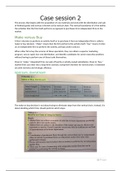Case session 2
The process that begins with the acquisition of raw materials and ends with the distribution and sale
of finished goods and services is known as the vertical chain. The vertical boundaries of a firm define
the activities that the firm itself performs as opposed to purchases from independent firms in the
market.
Make versus Buy
A firm’s decision to perform an activity itself or to purchase it from an independent firm is called a
make-or-buy decision. “Make” means that the firm performs the activity itself; “buy” means it relies
on an independent firm to perform the activity, perhaps under contract.
When other firms buy the services of these specialists, they can obtain a superior marketing
program, secure rapid, low-cost distribution, and identify candidates for senior executive positions
without having to perform any of these tasks themselves.
Close to “make,” integrated firms can spin off partly or wholly owned subsidiaries. Close to “buy,”
market firms can enter into a long-term contract, trying their interests for several years. In between
are joint ventures and strategic alliances.
Upstream, downstream
The make-or-buy decision is not about trying to eliminate steps from the vertical chain. Instead, it is
about deciding which firms should preform which steps.
1|Page
, Consumers will usually choose the finished good produced by the most efficient vertical chain. Thus,
if vertical integration improves the efficiency of production of wooden chairs, then the fully
integrated chair producer will prosper while the firms in the “independent” vertical chain will
struggle.
Defining Boundaries
The firm must compare the benefits and costs of using the market as opposed to performing the
activity in-house.
If it is cheaper to obtain an asset from the market than to produce it internally the firm
should do the former.
If the firm can perform the activity at a lower cost than it takes to buy it from the market, it
should do so.
Accounting profit is the simple difference between revenues and expanses. Economic profit,
represents the difference between the accounting profits from a given activity and the accounting
profits from investing the same resources in the most lucrative alternative activity.
The manufacturer should ask a critical question: “if the supplier of the input is so profitable, why
don’t other firms enter the input market and drive the price down?” perhaps because it is difficult
to obtain the expertise needed.
Reasons to buy
Markets firms enjoy 2 distinct types of efficiency: they exploit economies of scale and the learning
curve, and they eliminate “bureaucracy.”
Exploiting scale and learning economies
Firms should focus their activities on what they do best:
possess proprietary information or patents that enable them to produce at lower costs.
Might be able to aggregate the needs of many customers, thereby enjoying economies of
scale.
Might exploit their experience in production for many customers to obtain learning
economies.
Market firms can therefore often achieve greater scale, and thus lower unit costs, than can the
downstream firms that use the input.
Bureaucracy effects: avoiding agency and influence costs
Agency costs
Managers and workers who knowingly do not act in the best interest of the firm are shirking. Agency
costs are the costs associated with shrinking and the administrative controls to deter it.
Cost centerers are often insulated from competitive pressure because they have a committed
“customer” for their inputs. Moreover, it can be difficult to evaluate the efficiency of cost setters
because there is often no obvious market test for judging their performance. The absence of market
competition, coupled with difficulties in measuring divisional performance, makes it hard for top
management to know just how well a cost centre is doing relative to its best achievable
performance. This, in turn, gives cost centre managers the latitude to shirk.
Influence costs
2|Page





